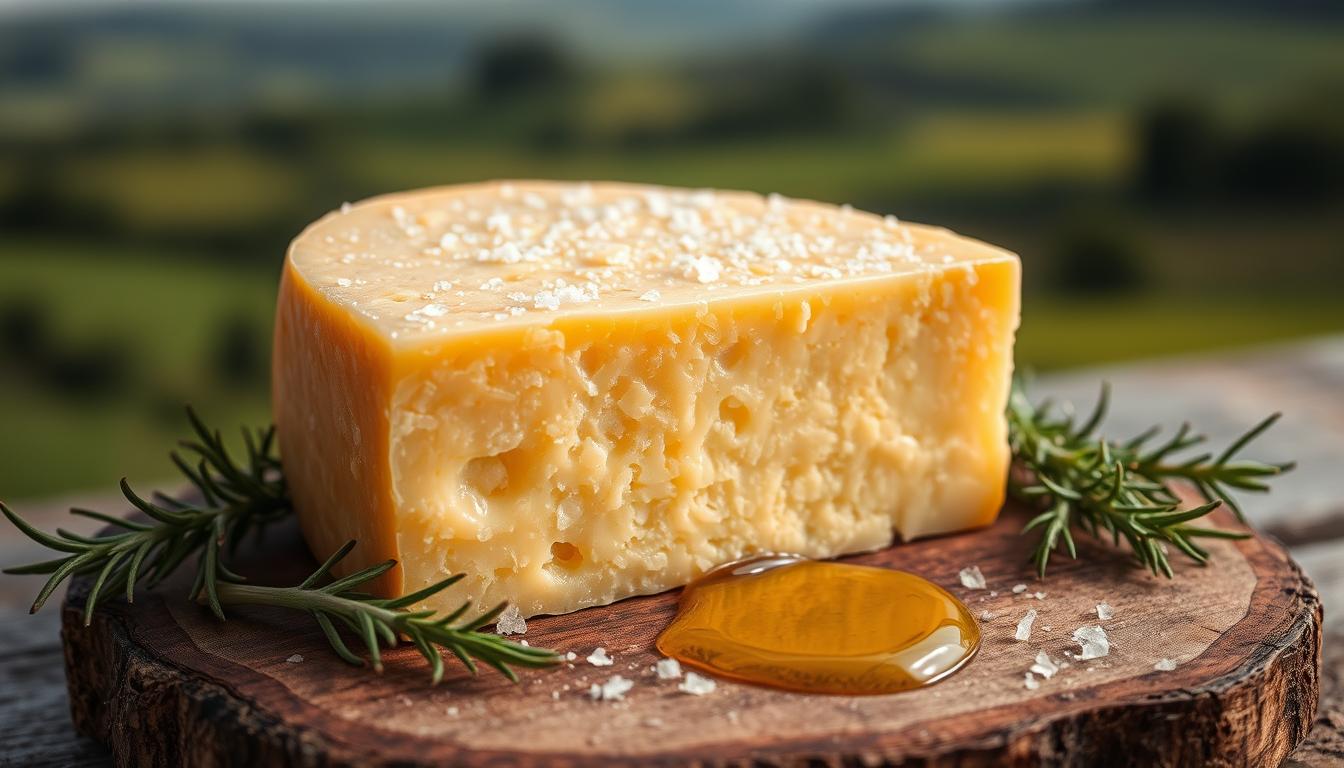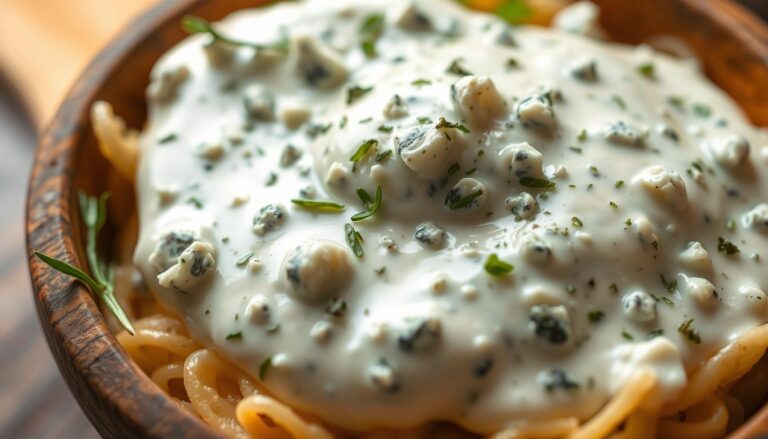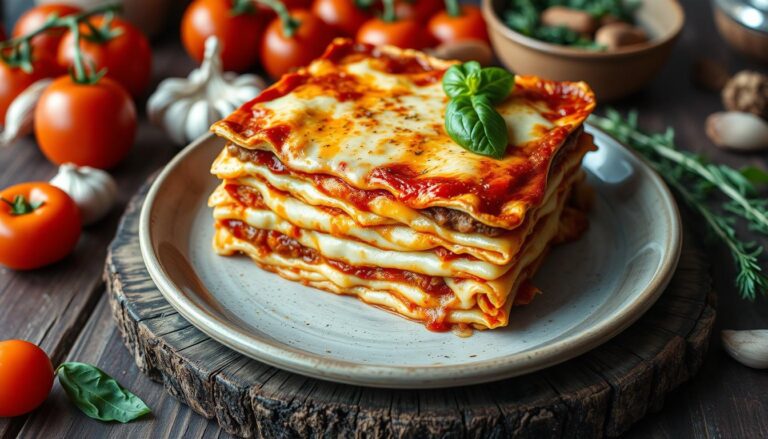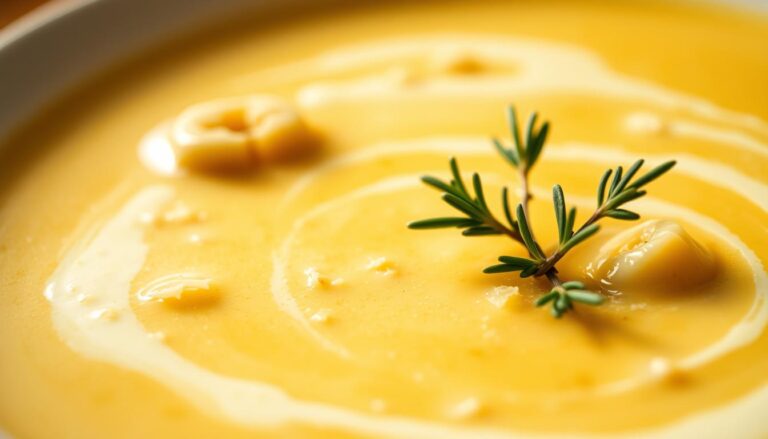Discover the Delicious World of Pecorino Cheese
Pecorino cheese is a type of Italian cheese made from sheep’s milk. It’s known for its rich, nutty flavor and firm texture1. This cheese has a long history, dating back over 5,000 years to the Neolithic period2. It’s still made in Italy today.
To learn more about Pecorino Romano, visit Pecorino Cheese. There, you can explore the world of Italian cheeses.
Understanding Pecorino Cheese Taste and Texture is key to enjoying it. Its flavors range from nutty and salty to mild and sharp3. This makes it great for many dishes. The cheese is made using traditional methods, giving it a distinct taste and texture that’s both firm and rich1.
Key Takeaways
- Pecorino cheese is made from sheep’s milk and has a rich, nutty flavor and firm texture1.
- Pecorino cheese has a history dating back to the Neolithic period, indicating a history of over 5,000 years2.
- There are different types of Pecorino cheese, each with its unique flavor and texture3.
- Pecorino cheese is a versatile cheese that can be used in various dishes, from pasta to salads1.
- Pecorino cheese can be stored in the refrigerator for several weeks and is best used within a month of opening for optimal flavor3.
What Makes Pecorino Cheese Special
Pecorino cheese has a rich history in Italy, named after the Italian word for sheep, pecora4. It’s often compared to Parmesan but has a unique taste. This makes it stand out in dishes like Pecorino vs Parmesan recipes. It’s a key ingredient in many Italian dishes, such as cacio e pepe and carbonara.
The cheese is made from sheep’s milk, mainly from the Sardinian Pecora breed4. The aging process can last from 20 days to 2 years, creating different flavors and textures5. For example, Pecorino Romano is aged for 8-12 months, becoming hard and tasting bold4.
Here are some key facts about Pecorino cheese:
- Pecorino cheese has about 110 calories per ounce (28 g)4.
- It has 23% of the daily recommended calcium in one serving4.
- Pecorino Romano is known for its sharp, salty taste4.
Pecorino cheese has a protected designation of origin. This means only cheese from certain Italian regions can be called Pecorino5. This status ensures the cheese’s quality and authenticity, making it a favorite among cheese lovers and chefs.
The Different Types of Pecorino
Pecorino cheese comes in many varieties, each with its own taste and texture. When you’re thinking about How to Use Pecorino in Cooking, knowing the different types is key. These include Pecorino Romano, Pecorino Toscano, Pecorino Sardo, and Pecorino Siciliano6. Pecorino Romano is famous for its sharp, salty flavor6.
The way these cheeses are made and aged affects their taste. For example, Pecorino Romano is aged for at least 5 months for table cheese and 8 months for grating cheese7. Pecorino Toscano is ready in 20 days for fresh cheese or 3 months for aged cheese6. Knowing these details helps you use Pecorino cheese in cooking and enjoy its taste and texture in different dishes.
The following table summarizes the main types of Pecorino cheese and their characteristics:
| Cheese Type | Aging Period | Flavor Profile |
|---|---|---|
| Pecorino Romano | At least 5 months | Sharp, salty |
| Pecorino Toscano | 20 days to 3 months | Mild, delicate |
| Pecorino Sardo | Varies | Less salty than Pecorino Romano, sharper with age |
| Pecorino Siciliano | 3 to 18 months | Varies with aging time |
Each Pecorino cheese offers a special taste and texture, making them great for Italian dishes6. Whether you want a sharp, salty flavor or something milder, there’s a Pecorino cheese for you7.
Understanding Pecorino’s Distinct Flavor Profile
Pecorino cheese is known for its bright and bold flavor. This flavor can change based on where it’s made and how long it’s aged8. For example, Pecorino Romano has a sharp, salty taste. It’s perfect for grating over pasta8.
The aging process is key in developing Pecorino’s flavor. It can age from 20 days to 18 months, depending on the type8. Some varieties age for 8 to 12 months, making their flavor more intense8. On the other hand, Pecorino fresco ages for just one month. This gives it a soft, springy texture9.
Regional differences also affect Pecorino’s flavor. Pecorino Romano is mainly made in Sardinia, while Pecorino Toscano comes from Tuscany8. Pecorino cheese is often described as sharper and funkier than Parmesan, which is milder9. For more on cheese, check out cheesevibes.com. They have lots of info on different cheeses, including Pecorino.
- Pecorino Romano: sharp, salty flavor, ideal for grating over pasta dishes8
- Pecorino Toscano: mild, nutty flavor, perfect for snacking8
- Pecorino Sardo: sweet, delicate flavor, great for desserts8
Pecorino vs. Parmesan: Understanding the Differences
Pecorino and Parmesan are two Italian cheeses often compared. Pecorino comes from sheep’s milk, offering a strong, earthy taste10. Parmesan, made from cow’s milk, has a nuttier, milder flavor10.
Pecorino is younger and moister than Parmesan, which ages for at least 12 months10. This aging makes Parmesan taste complex, even hinting at caramel in older varieties10. Pecorino is perfect for dishes like cacio e pepe, where its sharp taste shines10.
Choosing between Pecorino and Parmesan depends on your taste and the dish. Pecorino adds a bold flavor, while Parmesan offers a subtle, nutty taste11. Knowing the differences can elevate your cooking, making your Italian dishes authentic12.
These dishes highlight Pecorino’s unique taste and texture, showing how to use it in cooking12.
Cooking with Pecorino: Tips and Techniques
Pecorino cheese is great for many dishes, like pasta and salads. Its taste gets better with the right grating and cooking methods13. For grating, a Microplane grater is best. This is because it gives the cheese a perfect texture.
In dishes like Cacio e Pepe, Pecorino is grated over pasta. This makes a creamy sauce13.
To use Pecorino well, follow some key tips. Use 4 ounces of Pecorino Romano cheese, which is about 2 1/2 cups grated13. Also, mix the cheese with some cooking water to make it creamy. Here are some cooking tips with Pecorino:
- Choose high-quality Pecorino cheese for the best taste.
- Grate the cheese just before using to avoid it becoming too fine.
- Try different Pecorino types, like Pecorino Toscano or Pecorino Romano, to find your favorite14.
By using these tips, you can make the most of Pecorino cheese. You can make tasty Italian dishes like Cacio e Pepe and Carbonara15. Pecorino’s rich flavor and versatility make it a great choice for cooking.
Classic Italian Dishes Featuring Pecorino
Pecorino cheese is a key ingredient in many Traditional Italian Dishes with Pecorino, such as cacio e pepe and carbonara16. Its unique Pecorino Cheese Taste and Texture make these dishes iconic in Italian cuisine17. Cacio e pepe, or cheese and pepper, showcases pecorino romano cheese and black pepper17.
To make cacio e pepe, pasta is cooked al dente and mixed with cheese and pepper. This creates a creamy sauce17. The sauce should be creamy but not too thick, showing the right cheese-to-pasta ratio17. Some key characteristics of cacio e pepe include:
- Cooking time: approximately 20 minutes16
- Serving size: 1 ounce (28 grams) of Pecorino Romano cheese per person16
- Recommended amount of Pecorino Romano cheese: 2 ounces (about 55 grams)16
These Traditional Italian Dishes with Pecorino have ancient roots, showing their long-standing popularity17. The Pecorino Cheese Taste and Texture are vital to their cultural importance. They are a must-try for anyone wanting to taste true Italian cuisine16.

In summary, Traditional Italian Dishes with Pecorino showcase Italy’s rich culinary heritage. The unique Pecorino Cheese Taste and Texture are key to their lasting appeal17.
Pairing Pecorino: Wine and Food Combinations
Pecorino cheese pairs well with many wines and foods. It’s best with Pecorino wines, which come in different flavors18. These wines are richer than Pinot Grigio or Sauvignon Blanc, even if they cost the same18.
For the best taste, pair Pecorino with pork, fish, shellfish, and other Pecorino cheese18. The trick is to find foods and wines that match its flavor and texture. For example, Pecorino Romano’s salty taste goes well with sweet things like jams and honey19.
Here are some tips for a great cheese board:
- Choose a variety of cheeses, including Pecorino Romano and other Pecorino types.
- Pair the cheeses with fruits, nuts, and meats.
- Choose wines like Cabernet Sauvignon, Chianti, and Barolo to match the flavors19.
To enjoy Pecorino cheese, it’s important to know How to Store Pecorino Cheese right.
How to Select and Store Your Pecorino
To enjoy Pecorino cheese fully, knowing What is Pecorino Cheese? and how to store it is key. Storing and handling Pecorino cheese right keeps its quality and taste20. When buying Pecorino, choose varieties with a Protected Designation of Origin (PDO) like Tuscan Pecorino. It’s aged for 5 to 12 months and weighs about 66 pounds20.
For storing Pecorino, wrap it in a thermal box after each use. This can make it last about 2 weeks20. Also, remember that pasteurized Pecorino or aged for over 6 months is safe to eat20. For more on How to Store Pecorino Cheese, the ripening period for Pecorino Toscano DOP is 20 days for fresh and at least 4 months for aged21.
Here are some key tips for storing Pecorino cheese:
- Store in a cool, dry place
- Wrap in a thermal box after each use
- Consume within 2 weeks of opening
By following these tips and learning about Pecorino cheese, you can enjoy it at its best. Whether you’re curious about What is Pecorino Cheese? or How to Store Pecorino Cheese, proper handling and storage are crucial20.
Modern Applications and Creative Uses
Exploring How to Use Pecorino in Cooking opens up a world of possibilities. Pecorino cheese can elevate many dishes, not just traditional Italian ones. It’s great on cacio e pepe potatoes or in cauliflower recipes. Its taste and texture are perfect for modern recipes.
Pecorino is versatile in salads, as pizza toppings, or in sauces. It’s high in protein and low in lactose, appealing to health-focused eaters22. Plus, its production supports sustainable farming23.
Here are some creative uses for Pecorino in cooking:
- Top vegetables like Brussels sprouts or broccoli with Pecorino
- Add it to pasta dishes like carbonara or cacio e pepe
- Use Pecorino in sauces, such as pesto or arrabbiata
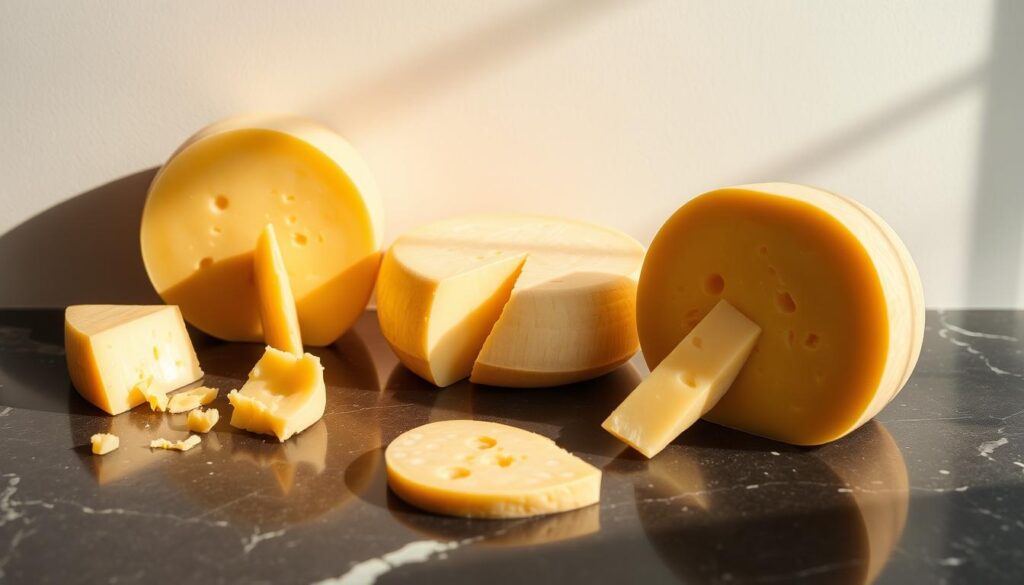
Italy leads in Pecorino Romano cheese production, making 25,000 tons yearly22. Most of it goes abroad, with 60% exported22. Its distinct Pecorino Cheese Taste and Texture make it a favorite among cheese lovers.
Conclusion: Embracing the Tradition of Pecorino in Modern Cuisine
Pecorino cheese is a favorite in Italy, adding richness to many dishes24. It comes from Italy’s heart and has kept its cultural and culinary value25. Today, it fits well in modern cooking, thanks to both old and new ways of making it24.
Pecorino is great on pasta, in sauces, or on a cheese board25. Its unique taste and flexibility make it a must-have for cooks25. Now, vegan cheeses are also available for those who want to enjoy Pecorino without dairy24.
By honoring Pecorino’s history and culture, we celebrate Italian cooking’s art. Find out how versatile Pecorino is and check out artisanal Italian cheeses to enhance your cooking.
FAQ
What is Pecorino Cheese?
Pecorino cheese comes from sheep’s milk and is a traditional Italian cheese. It has a rich history, dating back to ancient Roman times. It’s a key part of Italian cuisine.
How does Pecorino differ from Parmesan cheese?
Pecorino and Parmesan cheeses differ in their milk source and taste. Pecorino is made from sheep’s milk, while Parmesan comes from cow’s milk. Pecorino tastes saltier and sharper than Parmesan’s nutty, slightly sweet flavor.
How can Pecorino be used in cooking?
Pecorino cheese is very versatile in cooking. It’s great over pasta, in sauces, soups, salads, or as a snack. Its unique taste can elevate many Italian dishes.
What are the characteristics of Pecorino cheese’s taste and texture?
Pecorino cheese has a bold, salty, sharp, and slightly grassy taste. Its texture can be firm and crumbly when young or hard and crystalline when aged. The flavor and texture vary by region and production.
What are some traditional Italian dishes that feature Pecorino cheese?
Pecorino cheese is essential in many Italian dishes. It’s used in cacio e pepe, carbonara, and various Roman and Tuscan pasta and vegetable dishes.
How should Pecorino cheese be stored?
Store Pecorino cheese in the fridge, wrapped in wax paper or parchment paper. It keeps for several weeks when stored right.

